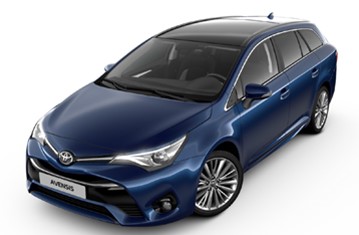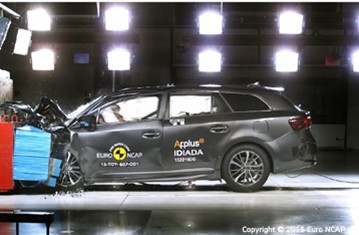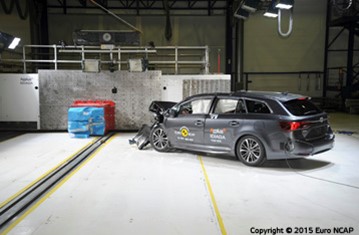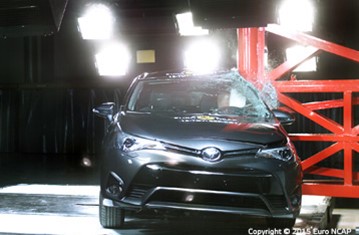Find more information in the General Comments section of the assessment
Find more information in the Rating Validity tab of the assessment
- See More
- See More
- See More
- See More
- Good
- Adequate
- Marginal
- Weak
- Poor
 Passenger
Passenger
 Driver
Driver
 Rear Passenger
Rear Passenger
 Driver
Driver
 Car
Car
 Pole
Pole
 Rear Seat
Rear Seat
 Front Seat
Front Seat
- Good
- Adequate
- Marginal
- Weak
- Poor


Passenger
outboard
center
Fitted to the vehicle as standard
Not fitted to the test vehicle but available as option
Not Available
-
Infants up to 13 kg
-
Infants and toddlers up to 18 kg
-
Toddlers from 9 to 18 kg
-
Toddlers over 18 kg
Easy
Difficult
Safety critical
Not allowed
| Seat Position | ||||
|---|---|---|---|---|
| Front | 2nd row | |||
| Passenger | Left | center | Right | |
| Maxi Cosi Cabriofix (Belt) | ||||
| Britax Römer King Plus (Belt) | ||||
| Britax Römer Duo Plus (ISOFIX) | ||||
| Britax Römer KidFix (Belt) | ||||
| Maxi Cosi Cabriofix & EasyFix (Belt) | ||||
| Maxi Cosi Cabriofix & EasyFix (ISOFIX) | ||||
| BeSafe iZi Kid X3 ISOfix (ISOFIX) | ||||
| Maxi Cosi Pearl & Familyfix (ISOFIX) | ||||
| Britax Römer KidFix (ISOFIX) | ||||
Easy
Difficult
Safety critical
Not allowed
The Avensis scored maximum points for its protection of the 1½ year dummy in the dynamic impact tests. In the frontal impact, forward movement of the 3 year dummy, sat in a forward-facing restraint, was not excessive although the neck recorded marginally elevated tensile forces. In the side impact, both dummies were properly contained within the protective shells of their restraints, minimising the likelihood of head contact with parts of the car interior. The front passenger airbag can be disabled to allow a rearward facing child restraint to be used in that seating position. Clear information is provided to the driver regarding the status of the airbag and the system was rewarded. All of the child restraints for which the Avensis is designed could be properly installed and accommodated in the car except for the large, Group II/III restraint which was unstable in the rear centre seat.
- Good
- Adequate
- Marginal
- Weak
- Poor

Head Impact 16.5 Pts
Pelvis Impact 5.7 Pts
Leg Impact 6.0 Pts
The bumper scored maximum points, providing good protection to pedestrians' legs in all areas tested. The Avensis provided protection to the pelvic region that was at least adequate. The bonnet was predominantly adequate with some good areas, and poor results being recorded only on the stiff windscreen pillars.
- Good
- Adequate
- Marginal
- Weak
- Poor
| Speed Limit Information Function | N/A |
| Warning Function | Manually set |
| Speed Limitation Function | Manually set |
| System Name | Vehicle Stability Control | |
| Performance | ||
| Vehicle Yaw Rate @ COS + 1.00 s | 2.8% | meets ECE requirements |
| Vehicle Yaw Rate @ COS + 1.75 s | 1.7% | meets ECE requirements |
| Lateral Displacement @ BOS + 1.07 s | 3.38 m | meets ECE requirements |
| Applies To | All seats | ||
| Warning | Driver Seat | Front Passenger(s) | Rear Passenger(s) |
| Visual | |||
| Audible | |||
|
|||
| System Name | Lane Departure Alert |
| Type | Lane Departure Warning |
| Operational From | 50 km/h |
| Warning | Audible & Visual |
| Performance | |
|
LDW Confirmation Test
|
Pass |
| System Name | Pre-Collision System | |||
| Type | Forward Collision Warning with Auto-Brake | |||
| Operational From | 10 km/h | |||
| Additional Information | Default On | |||
| Performance | | ||||
| Autobrake Function Only | Driver reacts to warning | |||
| Operational Speed | 10-80 km/h | 15-140 km/h | ||
| Approaching a stationary car | See AEB City | Crash avoided up to 65km/h.Crash speed reduced up to 80km/h. | ||
| Approaching a slower moving car | Crash avoided up to 65km/h.Crash speed reduced up to 70km/h. | Crash avoided up to 80km/h.Crash speed reduced up to 80km/h. | ||
| Following a car at short distance | ||||
| Car in front brakes gently | Avoidance | Avoidance | ||
| Car in front brakes harshly | Mitigation | Mitigation | ||
| Following a car at long distance | ||||
| Car in front brakes gently | Mitigation | Avoidance | ||
| Car in front brakes harshly | Mitigation | Mitigation | ||
Electronic stability control is standard equipment, as is a seatbelt reminder for front and rear seating positions. A driver-set speed limitation system is available as an option, as is a lane departure warning system. Autonomous emergency braking is standard and its performance at speeds typical of highway driving was rated as good. The auto-brake system was tested against a stationary car as part of 'AEB City' in Adult Occupant Protection and its performance in those tests is reported there.
- Specifications
- Safety Equipment
- Videos
- Rating Validity
Specifications
Tested Model Toyota Avensis 1.6 D-4D Touring Sports, LHD
Body Type - 5 door wagon
Year Of Publication 2015
Kerb Weight 1550kg
VIN From Which Rating Applies - all Avensis Sedan and Avensis Touring Sport, petrol and diesel, with the safety equipment fitted to test car
Class Large Family Car
Safety Equipment
Note: Other equipment may be available on the vehicle but was not considered in the test year.
Fitted to the vehicle as standard
Fitted to the vehicle as option
Not fitted to the test vehicle but available as option
Not Available
Not Applicable
Videos
Rating Validity



Find more information in the General Comments section of the assessment
 Share
Share











The passenger compartment of the Avensis remained stable in the frontal offset test. A knee airbag is standard for the driver's seating position. However, deployment of the airbag in the offset test resulted in dummy knee readings which indicated some risk of injury. As a result, Toyota were not allowed to demonstrate that structures in the dashboard - airbag support bracket, ignition barrel, steering column and adjuster - would not also be injurious. The results for the knee/femur/pelvis body region were penalised and protection was rated as marginal. Otherwise, protection was rated as good or adequate. In the full-width frontal impact, protection was good for all critical body areas of the driver. For the rear passenger, protection of the chest was rated as marginal while that of all other parts of the body was good. The Avensis scored maximum points in the side barrier impact, with good protection of all critical body areas. Likewise, in the more severe side pole test, protection was good. The front seats and head restraints provided good protection against whiplash injuries in the event of a rear impact and a geometric assessment of the front seats also indicated good whiplash protection. A standard-fit autonomous braking system operates from the low speeds, typical of city driving, at which many whiplash injuries are caused, and its performance was rated as good.